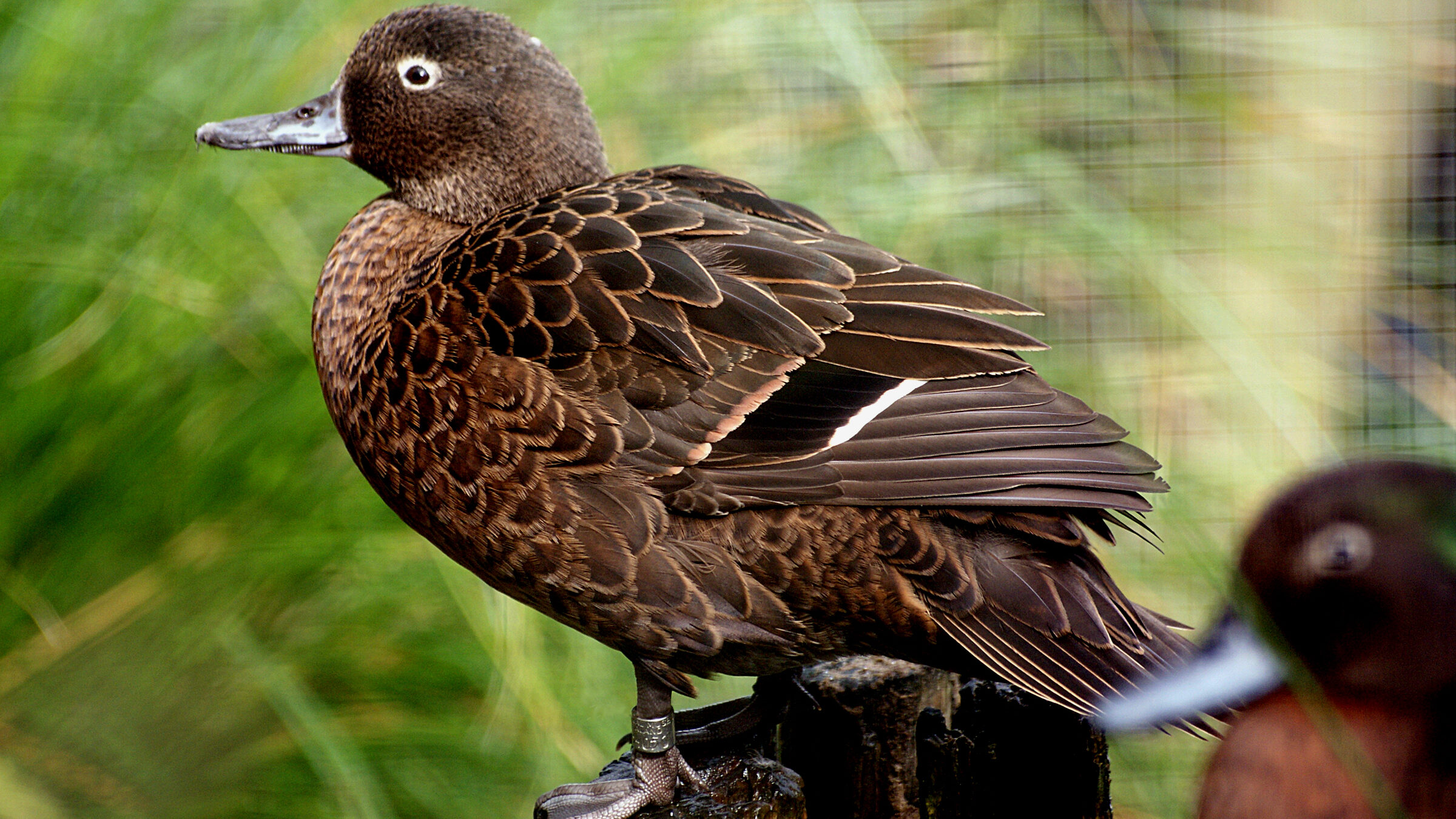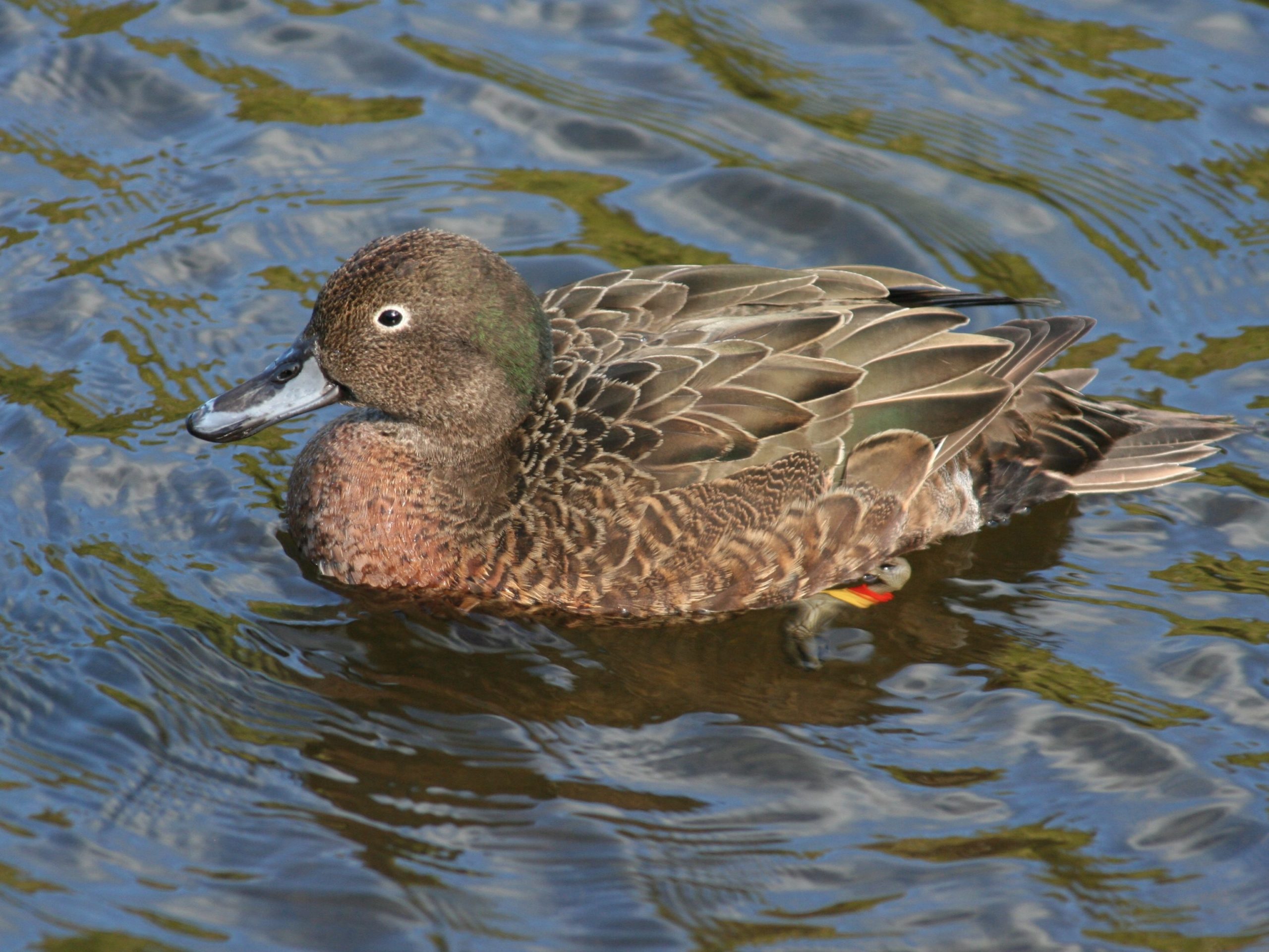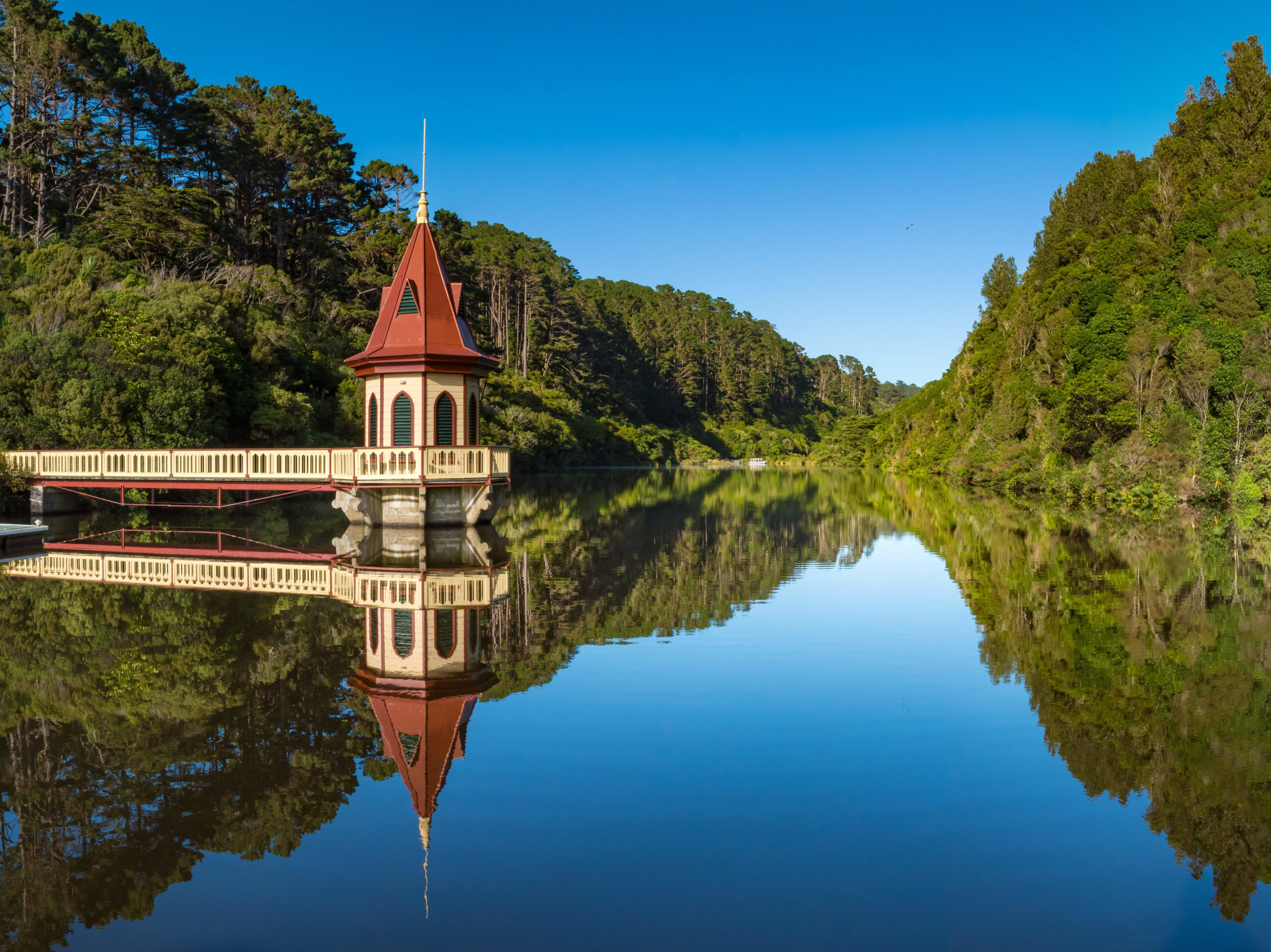Pāteke/brown teal are mainly nocturnal, small dabbling ducks found only in New Zealand. They once inhabited a wide range of habitats including wet forests, swamps, slow-flowing streams, lakes and estuaries and in pre-human times may have been the most wide-spread and abundant of our waterfowl.

Even 200 years ago brown teal were abundant and widespread and up until 1972 they could still be found on Stewart Island. But now they’re mainly found in Northland, Great Barrier and Little Barrier Islands and Coromandel Peninsula. They’re our rarest mainland waterfowl.
It was the usual story – habitat destruction, draining of wetlands – and introduced mammal predators. Pāteke are being successfully bred in captivity but good, predator-managed habitat is needed for a successful translocation to the wild and suitable sites are limited.
Translocations have failed in the past. Researchers Katie Sheridan and John Waldman studied pāteke living at Zealandia in Wellington with the aim of better understanding their needs and increasing the options and odds for successful future releases. The results of their study are published in Ecological Management and Restoration.
“Captive breeding and reintroduction of birds to predator-controlled environments offer a promising means for species recovery. However, these actions pose challenges to a founder population’s ability to become established.”
Lack of knowledge meant early attempts at captive-rearing and release weren’t successful
“As the need for conservation of pāteke became increasingly apparent, the New Zealand Wildlife Service began a captive breeding programme in 1964 and transferred operations to Ducks Unlimited NZ in 1974, after which the number of captive-bred individuals increased exponentially. With large numbers secured in captive facilities, suitable release locations were considered. Several aspects were overlooked, however, during selection of release sites, including non-native predator abundance; post-release population monitoring; minimum release number for sustainable and genetically viable populations; and habitat quality, composition and size of release site.”
Population numbers continued to drop.
“Dozens of releases of pāteke were carried out beginning in 1968, but were met with little success and pāteke was listed as endangered in 1994. In 1999, the population still hovered at only about 800 wild individuals. Stagnation in release success accompanied by dwindling remnant populations and the pāteke’s IUCN listing created the impetus for the Department of Conservation (DOC) to temporarily scale back pāteke captive breeding efforts and focus resources on identifying, restoring and maintaining suitable release locations, and on monitoring the condition of newly released pāteke.”
Good predator control was essential.
“This strategy is detailed in the Pāteke Recovery Plans (1996, 2007), which highlight the need for intensive predator control at release sites. With emphasis placed on selecting predator-controlled locations, releases were met with increasing success and pāteke’s IUCN Red List classification was downgraded from ‘endangered’ to ‘near-threatened – increasing’ in October 2015.
So far, so good – but the number of suitable predator-free islands for release is limited.
“While predator-free islands (e.g. Kapiti, Mana and Rotoroa Islands) supported pāteke releases for a time, there is concern as to whether other attributes of many of these islands (e.g. size, habitat and distance to other populations) limit their ability to support viable populations in the long term . More recently, mainland ‘islands’ consisting of intensively predator-controlled, often fenced, natural environments have been trialled as suitable release sites for vulnerable native species, including pāteke. Mainland ‘island’ pāteke releases (e.g. Cape Sanctuary, Tawharanui Regional Park and Habitat te Henga) have been met with promise.”
To date, mainland release sites have been limited to those that consist of habitat similar to the low-lying coastal wetlands inhabited by the remnant populations in the far north, but might other types of habitat – including wet forests – also be suitable?
“Primarily forested, predator-controlled sites have yet to be given serious consideration despite pāteke historically inhabiting the bush. A criticism of trialling bush releases is that forested sites supply habitat of insufficient or marginal quality.”
There is good evidence, however, that pāteke are opportunistic feeders. They’re known to feed on at least 78 taxa, including acombination of terrestrial and aquatic invertebrates and vegetation.
“Also, review of fossil records and a comparison of diet variation through stable isotope analysis showed that some pāteke were forest floor omnivores and were well-suited to live in forests. With regard to habitat utilization, nearly all previous field-based studies have focused on pātekes’ use of coastal (and adjacent pastoral) habitat. However, it is not necessarily best practice to restrict future conservation efforts for a species on what is known of small and declining populations, particularly since their current range is an extremely truncated representation of their natural range.”
Earlier researchers have urged increased exploration and efforts in trialling fenced, forested wildlife sanctuaries for the release of pāteke. This current research project took up that challenge.

“This study evaluates home range attributes and roosting and foraging patterns within Zealandia Ecosanctuary (Wellington) of pāteke (brown teal) with the goal of assessing suitability of forested, predator-controlled sanctuaries as future pāteke release sites, a habitat type currently considered as unsuitable to the species or of marginal quality.”
The researchers evaluated roosting and foraging patterns and home range attributes of the population of pāteke residing within the fenced and primarily forested Zealandia Ecosanctuary in order to determine suitability of similar sites for future pāteke release.
“Since Zealandia contains both forest and lakes, this site presented an opportunity to compare foraging, roosting and home range attributes between groups of individuals using predominantly forested vs. predominantly aquatic habitat.”
Zealandia’s founding population of 18 individuals was released in November 2000 and April 2001, marking the first release of pāteke into a primarily forested, predator- controlled environment. For this study, VHF telemetry and motion-sensing cameras were used to track seven forest-dwelling pāteke (‘bush pāteke) and three lake-dwelling pāteke (‘lake pāteke) descended from that initial population.
“To better understand the ecology of pāteke in this predator-controlled preserve, we used VHF telemetry and motion-sensing cameras to identify the size of individual home ranges and their core roost areas and the extent to which home ranges and core roost areas overlap with other individuals. We also evaluated the relative distances of lake pāteke and bush pāteke roost from lake edges as well as overall length and type (i.e. stream or lake edge) of bush pāteke and lake pāteke foraging ranges to delineate behaviour and habitat preferences of Zealandia’s pāteke.”
Zealandia’s habitat includes two lakes with various tributaries feeding into them, surrounded by forested hills and wetlands.
Home range and core area sizes were calculated for the 10 pāteke who had between 34 and 220 total telemetry fixes each. All transmittered pāteke had home ranges which overlapped with between 1 and 6 other transmittered pāteke. Overall, the study offered compelling evidence that forested release sites are suitable for pāteke, provided several conditions are met.
“Results elucidated key behavioural differences between pāteke which reside in the bush vs. those who stay primarily along lake edges, exemplifying pāteke resiliency and adaptability. Lake pāteke home range size (mean = 3.52 ha) was significantly smaller than for bush pāteke (mean = 24.71 ha). Mean roost distance to the nearest lake was significantly shorter for lake pāteke (mean = 3 m) than that of bush pāteke (mean = 643 m). Two estimates of the percentage of lake edge to forest stream foraging distance percentage were significantly greater for lake pāteke (mean = 56.1% or 59.0%) than that of bush pāteke (mean = 5.3% or 5.7%).”
For forested habitats to provide suitable release sites for pāteke, predator control must be ongoing; a flock site must be available; supplemental feeders should be available temporarily upon release; and the site must be large enough to accommodate at least 50 pairs of pāteke, according to the researchers.

“Pāteke home range attributes have significant implications for species management as they relate to the suitability of potential future release sites. Release sites containing habitats that lead to individuals utilizing larger home ranges (i.e. forested habitats) would require that the overall release site be large enough to accommodate a sustainable population of at least 50 pairs of pāteke. Maintaining predator-controlled environments of larger sizes incurs larger costs and labour requirements and may not be feasible. In all cases, however, appropriate habitat composition within release sites remains an important consideration.”
So why might bush pāteke need a bigger home range? What are the advantages and disadvantages?
“Bush pāteke maintained significantly larger home ranges than lake pāteke, suggesting that resources are sparser in the forest. While lakeside and wetland habitats may contain more concentrated food sources, this does not necessarily mean that lakeside residency is preferred, nor does this preclude forested habitat from being suitable, since factors other than food availability influence habitat selection. The advantage of roosting in the bush, hidden by dense vegetation, may outweigh the costs of travelling farther for food. Bush inhabitance may also gain preference since it is less densely populated; conspecifics interact less frequently and so potentially invest less energy defending resources.”
Bush pāteke need:
- significantly larger individual home ranges than their lake-dwelling relatives;
- home ranges that must include specific habitat features (i.e. stream corridors for foraging, flock site and dense vegetation for roosting); and
- there must be minimal overlap with adjacent home ranges
This means that a predator-controlled, forested facility that would accommodate a sustainable population must be much larger than a release site dominated by wetlands and tall grasses. If the release site is too small, low population numbers will lead to inbreeding, reduced fertility and population decline over time.
Are our current fenced sanctuaries big enough? Predator-controlled ‘halos’ surrounding fenced sanctuaries may be part of the solution.
“Projects such as the Enhancing the Halo Project, which implements continuous non-native predator trapping within a large buffer area surrounding Zealandia, provide increased potential for pāteke and other vulnerable native fauna and flora to exist in the bush outside and adjacent to Zealandia. This generates a larger combined potential carrying capacity than Zealandia or the buffer area separately. Some of Zealandia’s pāteke have been recorded outside the fence, lending credibility to this concept.”
The researchers also looked at roost sites used by lake and bush pāteke.
“Lakeside roost sites had similar characteristics to one another and shared similarities with pāteke roost sites described in northern remnant population habitats. Zealandia’s lakeside roosts, including the flock site, consist of flat banks lining lake edges, stream inlets, an abundance of tall sedges and rushes, and overhanging vegetation. Preferred lakeside roosts offered greater plant species richness than preferred bush roost sites.”
“All preferred bush roosts contained a dense (impenetrable to humans) understory that often consisted of a Blechnum novae-zelandiae monoculture understory. Preferred bush roosts were situated relatively close to streams (0 to 60 m away), along which the resident pāteke were seen foraging at night. The stark contrast between preferred lake and bush roost sites at Zealandia reaffirms this species ability to survive in diverse conditions.”
The difference in bush and lake preferences may also by a response to the presence of mammal predators.
“In environments where mammalian predators are abundant, such as in the northern population strongholds, lakeside roosts may be advantageous over bush roosts in that they offer a quick escape route where pāteke can take flight over water to evade predators. In predator-controlled environs, however, the isolation of bush roosts may gain preference. Given that several of these individuals have inhabited the forests of Zealandia for 10 or more years, individuals have retained the ability to roost in diverse habitats successfully.”
Mammal predators are the biggest, but not the only threat facing pāteke.
“After mammalian predation, the greatest threat to pāteke survival is starvation. An argument against predator-controlled forested sites for pāteke release is that these sites may offer unsuitable feeding habitat. Pāteke historically foraged in highly varied habitats; however, centuries of anthropogenic land alterations (farming, exotic animal introduction, clear-cutting and draining of wetlands) have diminished habitat quality, likely limiting food abundance. This phenomenon affects not only their previously inhabited forested environments, but also the coastal and estuarine environs inhabited presently by remnant populations.”
“Pāteke have persisted longest in coastal northern locales for several reasons, including later arrival of mammalian predators; comparatively lower density of mammalian predators; historically high concentrations of pāteke at these locations; and continued availability of suitable habitat. Thus, there is a strong possibility that selective forces other than dietary needs influenced the locations of present-day remnant pāteke strongholds.”
The researchers argue that claims that forests provide insufficient food for pāteke are unsubstantiated.
The foraging analysis revealed that lake pāteke and bush āpteke differ significantly in their foraging patterns (i.e. lakeside to expansive linear foraging range), and suggest that food may be more concentrated along lake edges and sedge-dominated wetlands. However, the study revealed that many pāteke still chose to forage almost exclusively within the forest and that forested streams were frequently foraged by lake pāteke. There was no evidence to suggest that lake pāteke were fitter than bush pāteke.”
One possible issue is whether pāteke can adapt to a forest diet after many generations of coastal foraging, but the researchers believe they can adapt – provided they have feeder support in the initial release period.
“The pāteke digestive tract can alter its morphology to facilitate efficient digestion of available food. Morphological adaptations are most significant when pāteke are transitioned between fibre- poor unvaried diets consumed by captive-fed pāteke and fibre-rich, varied diets typically available in the wild. This suggests that pāteke have the physiological capacity to accommodate a transition from coastal or captive to forested diets. Installation of stationary feeders for at least 2 months upon release is recommended to supplement pāteke diet while they adapt to the change in diet composition and the new foraging behaviour required of them.”
“The physiological capacity for forest foraging was evident when analysing foraging behaviour of Zealandia’s pāteke. Food within forested streams was a key dietary component for all 10 transmittered pāteke. That numerous founder pāteke as well as older pāteke spent the vast majority of their observed foraging time within and proximate to the forested streams suggests that forest diet is sufficient and that pāteke have retained the behavioural and physiological plasticity necessary for effective forest foraging.”
Overall the Zealandia pāteke research has some key implications for managers:
- Appropriate habitat composition within release sites remains an important consideration.
- Release sites must be large enough to accommodate at least 50 pairs of pāteke, and forested release sites may require considerably more space than traditional sites.
- Ongoing predator control, including in areas adjacent to release sites, plays a critical role in establishing and maintaining a successful pāteke population in a forested environment.
- Future releases should be cognizant of the extent to which founder birds are inbred as this could be the driving factor in differences in overall fitness, impartial to habitat.
The full research report is published in Ecological Management and Restoration. Only the abstract is freely available online.

